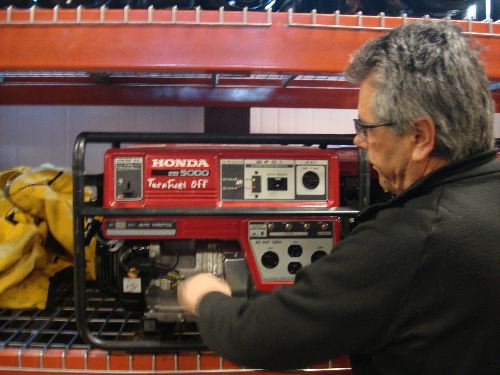Packing, training, packing, training.... Being a researcher in Antarctica requires a fair amount of effort! It truly is amazing how much effort goes into getting the data for the research being done. There is an incredible support system in place in order to make it all happen. Not only are the researchers here, but all the personnel needed to support the research are also here: pilots, technicians, welders, doctors, cooks, mountaineering guides, divers, carpenters, housing people, custodial staff, even a hairdresser! That's only mentioning a few! McMurdo functions like a well oiled machine. Check out the video showing seens from around town in McMurdo and over at Scott Base.
http://
We started the day with more training. First, we had our environmental preservation and waste management lecture. This consisted of a review of conservation laws and practices, and plans of action in case there is some sort of incident that threatens the environment. It is nice to see such strict guidelines and efforts in place to help conserve this pristine environment. The Dry Valley area requires an extra series of information. This area is at its extreme edge of being able to sustain life. Because of this, it is an extremely sensitive area. Human impacts can have long lasting effects in the area, so extra efforts and regulations are designed to help conserve this fragile ecosystem.
We then went to pick up our VHF (very high frequency) radios. Each of us will have a radio with us at all times when we are in the field. These radios function on a "line of site" basis. This means that as long as our radios can "see" each other we can communicate. If we go out of range of the line of site, we can extend the range by bouncing the signal off a repeater station. These stations sit high on the tops of local mountains and are thus in the line of site with the radios. We can send a message to the repeater station and it will bounce the signal to another radio. We can also bounce the signal off the repeater to get our messages to McMurdo if needed. I wonder if we could get pizza delivered? For most of our time in the Taylor Valley, we will use the Mt. Coates repeater station if we need to extend the range of our radios.
Map of Taylor Valley
 181dryvalleymap
181dryvalleymap
Taylor Valley map from: http://wy.water.usgs.gov/projects/antarctica/images/map3.jpg
Next, we picked up supplies from the Berg Field Center; this is where all camping supplies are kept. We picked up our sleep kits (sleeping bags, ground pads, liners, pillows, pee bottles, water bottles, water bottle insulators, etc), tents, ice axes, ice chippers, fuel spouts, banana sleds, backpacks, tools, etc. We transferred all this equipment to the "staging area" in the Crary Lab. The Crary lab is the science building. This is where the researchers have offices and lab space to work and conduct some of their experiments. The staging area is a place in the loading bay where equipment can be assembled, packaged, and stored temporarily prior to being sent to the helicopter hanger for transport to the field station.
The Berg Field Center has a giant "Macopoly" board painted on the floor. What's the most valuable property? The Dry Valleys! No one gets any cookies if they miss their "check in" time. Each day, field camps are required to report back to Mac Ops (McMurdo Operations) the status of the group. This is basically a way for the safety personnel back in town to know that everyone is safe. If you miss your check in time, Mac Ops will make a few efforts to contact you, but if contact is not made within an hour, an emergency response is put into action. This may lead to town sending a search and rescue party out to find you - including a helicopter! Bad news if you simply overslept! Check in times are taken VERY seriously! That's a good thing!
 179macops.JPG
179macops.JPG
Mac Ops Control Center
 178macops.JPG
178macops.JPG
Annika and Maciej review where the repeater stations are located in the Dry Valleys.
 177macopoly.JPG
177macopoly.JPG
The "Macopoly" Board!
 176dryvallmacopoly.JPG
176dryvallmacopoly.JPG
The Dry Valleys; the most prized property!
We also went to a refresher course on how to make repairs on the machinery that we will be using in the field - jiffy drills, generators, and ATV's to name just a few.
 165rickjiffy.JPG
165rickjiffy.JPG
Rick reviews the finer points of the Jiffy drill!
 166rickgenerator.JPG
166rickgenerator.JPG
Rick shows us the proper sequencing for using the generator with the hotsy.
 167rickhotsy.JPG
167rickhotsy.JPG
Rick reviews the main concerns about using the "hotsy"; I'll explain more about this machine in a subsequent journal!
We ended the day with a lovely visit over to Scott Base to meet up with Ian, Asland, and Hilke. The "Kiwi's" - New Zealand researchers - and the McMurdo folks are collaborating on this research in the Dry Valleys. Visiting the lounge at Scott Base is typically through invitation only. It was a wonderful excuse to get out of "Mactown" and see the other side of the mountain. The view is spectacular!
 175kiwibase.JPG
175kiwibase.JPG
Coming in on Scott Base
 170erebusscott.JPG
170erebusscott.JPG
Welcome to "The other side of the mountain" - Mt. Erebus... still chugging away!
 168tatscott.JPG
168tatscott.JPG
TAT enjoyed his time at Scott Base! He realizes he's a long way from home!
 169teamscott.JPG
169teamscott.JPG
Annika, me, and Maciej at the base locator sign!
 172kiwicross.JPG
172kiwicross.JPG
Just a fun sign!
 171pressureridge.JPG
171pressureridge.JPG
These pressure ridges are huge! They form when the sea ice grinds up against the shelf ice!
 173blackflags.JPG
173blackflags.JPG
Black flags are the universal sign for danger here. It is well known to stay well clear of the black flags!
 174scottbaseme.JPG
174scottbaseme.JPG
I'm pretty far from home too!
What happens on October 21? Here's a hint!
 180macsunset.JPG
180macsunset.JPG
You can also check out my journals and pictures from previous seasons at: http://www.ryejrhigh.org/ellwood

